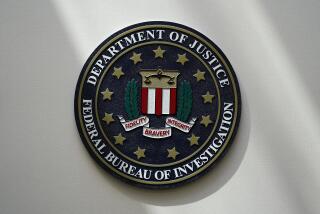2 Men Held in Alleged Plot to Bomb N. California Sites
SACRAMENTO — Amid heightened concern by state and federal officials over potential terrorist acts on New Year’s Eve, two militia members were arraigned here Tuesday on firearms charges related to an alleged plot to blow up targets in Northern California.
According to a court document in the case, one suspect discussed a potential bombing of the California Aqueduct, a Pacific Gas & Electric station on California 99 and two large propane tanks in Elk Grove, a suburb south of Sacramento.
A search of the two men’s homes uncovered more than 50 firearms, 50,000 rounds of ammunition and about 30 pounds of fertilizer that could be turned into explosives, according to federal officials.
An inch-thick affidavit filed by agents of the FBI and the U.S. Bureau of Alcohol, Tobacco and Firearms is laced with other references to turmoil, such as the failure of nuclear reactors, that might occur on the eve of the new millennium.
But the Sacramento incident is the most dramatic example yet of both the potential danger of Y2K-related terrorism and of concerted federal and state efforts to block it. With computer systems now viewed as fairly stable, the main remaining fear among law enforcement officials, especially in California, is of millennial terrorism by fringe groups.
Even before the latest arrests, federal agents had focused on terrorist and militia threats in Northern California. Two brothers from Redding were arrested last summer in the slayings of a gay couple there and are considered suspects in arson fires at three Sacramento synagogues. And a Yolo County man was arrested this week in connection with the firebombing of a synagogue in Reno.
“The problem has clearly existed for quite a while,” said James Maddock, special agent in charge of the FBI’s Sacramento office, who leads a multi-agency terrorist task force. Once it was formed last year, he said, it was “clear there was no shortage of business.”
Some of its focus is on groups that believe the new millennium will bring about social unrest, said several law enforcement sources.
Wearing orange jail jumpsuits, Kevin Ray Patterson, 42, of Camino, and Charles Dennis Kiles, 49, of Placerville, identified in the affidavit as members of a Central Valley anti-government militia, appeared in U.S. District Court on Tuesday. They were arrested last week as the result of a yearlong investigation by the federal anti-terrorist task force.
In the affidavit, unsealed this week, agents for the FBI and the Bureau of Alcohol, Tobacco and Firearms said they were told by an unnamed member of the San Joaquin County Militia that the group “intended to cause social unrest through violent criminal actions that cause the government to declare martial law.”
The document indicated that both arrested men were also members of the militia, though details about the organization are not spelled out.
In October, the FBI issued a report to police chiefs labeled “Project Megiddo,” named for a hill in northern Israel that the Bible designates as the assembly point in the apocalyptic setting of God’s final battle against evil.
The introduction of the report says: “The name ‘Megiddo’ is an apt title for a project that analyzes those who believe the year 2000 will usher in the end of the world and who are willing to perpetrate acts of violence to bring it about.”
The report lays out the problem facing police as they look toward the new millennium, a problem allegedly reflected in the case of Patterson and Kiles.
“Even well-established militias, which tend to organize along military lines with central control, are characterized by factionalism and disunity. . . . The overwhelming majority of extremist groups in the United States have adopted a fragmented, leaderless structure where individuals or small groups act with autonomy,” the report stated.
While Project Megiddo identified very few specific threats to domestic terrorism, the millennium is a pivotal time for many groups.
The report continues: “Several religiously motivated groups envision a quick, fiery ending in an apocalyptic battle. Others may initiate a sustained campaign of terrorism in the United States. . . . Armed with the urgency of the millennium as a motivating factor, new clandestine groups may conceivably form to engage in violence toward the U.S. government or its citizens.”
In Sacramento, the federal informant told agents that Patterson first raised the possibility of targeting the propane facility in Elk Grove in June 1998. He believes Patterson talked about it while returning from Billings, Mont., where he assisted other militia members in surveillance of the Yellowstone County Jail.
According to the affidavit, the surveillance was in anticipation of a militia operation to break the Montana Freemen out of custody.
Dwight M. Samuel, Patterson’s attorney, would not comment on whether the men were members of any paramilitary organizations or whether they were focused on Y2K. “It would be a normal gun case without all the other stuff, the allegations of bombing the twin towers” propane tanks, he maintained.
The tanks, located near homes and heavily traveled California 99, hold 24 million gallons of volatile liquid propane.
The affidavit noted that a study conducted for investigators by Lawrence Livermore National Laboratory “concluded, in part, that a successful attack on either of the larger . . . tanks would likely result in a firestorm that could reach as far out as 14 kilometers [about 10 miles] from the site and could cause a fatality rate as high as 50% up to five miles away.”
Kiles was detained in the Sacramento County Jail without bail, but Patterson, who is also jailed, was granted a bail hearing for Thursday. Magistrate Judge Dale Drozd set a preliminary hearing for both men for Dec. 20.
More to Read
Sign up for Essential California
The most important California stories and recommendations in your inbox every morning.
You may occasionally receive promotional content from the Los Angeles Times.









